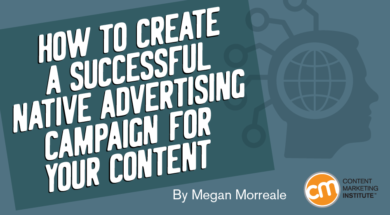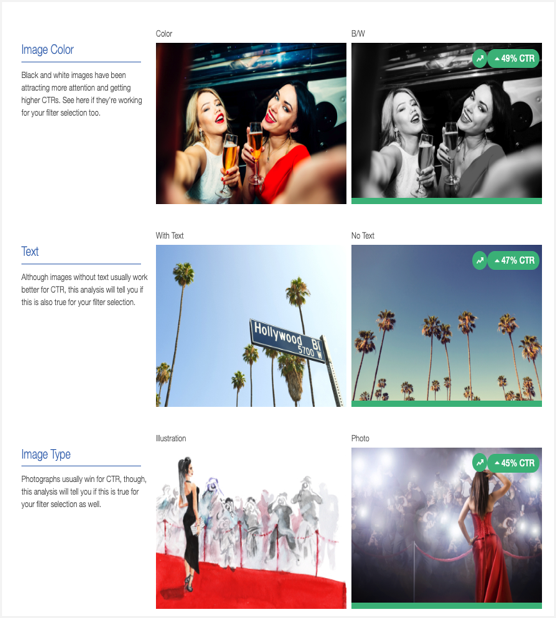
No matter how much care you put into knowing your audience and carefully crafting content, your native advertising campaign will fail if your creatives aren’t engaging and your targeting isn’t relevant.
Native advertising has become a valuable tool in content marketers’ arsenal, but – as with other channels – it’s only effective if you do it right.
A lot goes into doing it right, revolving around these six pillars:
- Catering to the native advertising mindset.
- Choosing the right content for the channel.
- Using different content to qualify the audience.
- Building effective ads.
- Targeting like a pro.
- Measuring and A/B testing.
At Taboola, we run 1.4 billion content recommendations in the form of native ads every day. Here’s what a network-wide analysis of these content-focused ads has taught us.
These recommendations are based on areas of opportunity for marketers – the intersection of supply and demand. Supply is indicated by the percentage of spend across the network. Demand is indicated by click-through rate. (The assumption is that people clicking on the content indicates demand.)
1. Cater to the native user’s mindset
People who click on native advertising aren’t in the same mindset as users on search and social channels.
Users on search channels have a clear intent – they have a question and want an answer, whether they’re looking for information, a product, or the web address of a brand they like.
Users on social channels are looking for news, recommendations, or content from people, publications, and brands they’ve identified as part of their tribe.
Users of native advertising are in a different mindset – they click to explore content or a website because they’re ready to discover something new. As such, the content that finds success on native advertising often explores new concepts, entertains, or informs.
Successful #nativeadvertising #content offers new concepts or entertains, says @MeganRoseM. Click To Tweet
2. Choose the right content type
We analyzed four content types: (1) text-based, which includes blog posts, earned media articles, and gated content, (2) photo galleries, (3) video, and (4) all other.
Photo galleries and videos are the biggest opportunity for content marketers. Consider testing visual content for your next campaign.
The biggest opportunity in #nativeadvertising content is in photo galleries and videos, says @MeganRoseM. Click To Tweet
3. Use different content to qualify your audience
Your advertised content assets should act as a qualifier to identify the audience the campaign is designed to support. Though the content will look different depending on your industry, I share how three verticals could do it.
Education
These hypothetical native ads are for an online university. Each piece of content qualifies users for the next stage of the funnel.

People who click on the first piece of content – You Can’t Argue With Public Speaking Course Results – may be interested in online education.
The second article, Here’s How to Level Up at Work Without Leaving Home, qualifies people who want to improve or advance their careers without physically attending class.
Finally, Starting a Career in Marketing with This Degree Program qualifies people interested in completing an online degree.
Finance
These hypothetical examples would work for a mortgage lender.

The first piece, How to Get Your Finances Ready for the Holidays, qualifies users who are interested in financial health.
The second, 5 Things You Should Know Before Buying a Home, qualifies users who are interested in the type of financial product this brand provides – mortgages.
The last piece of content qualifies users who are interested in acquiring a mortgage.
Fashion
Finally, I illustrate potential native advertising for an e-commerce fashion brand.

The first piece, How to Be Happy Every Time You Open Your Closet, qualifies people who are interested in purchasing new clothes.
The second piece, 6 Items to Throw Out (and What to Replace Them With), qualifies people who are looking to make new clothing choices soon.
And finally, Dresses Inspired From the Runway Starting at $49, qualifies potential buyers.
You get the idea – whether the content behind these titles hosts a video, a photo gallery, or text-based content, these topics are tied to a step in the user journey.
Your advertised content topics should be tied to a step in the user journey, says @MeganRoseM. Click To Tweet
4. Build effective ads
The first three pillars don’t matter unless you can grab someone’s attention with the native ad creative.
As shown in the examples, most native ads combine a headline and thumbnail. Video is another popular option. Taboola collects unique data from a weekly analysis of millions of native ads to help understand elements of successful native ads. But before diving into the data, I want to emphasize that honest native advertising is key. If your headlines, images, and videos aren’t relevant to the content you’re promoting and aren’t relevant for your brand, they’ll flop.
If your native ad’s headlines and images aren’t relevant to the content, the ad will flop, says @MeganRoseM. Click To Tweet
Create clickable creatives, not clickbait. Let’s dive deeper into the research.
Headlines
Including effective keywords in your headlines gives your native ads a better chance of getting a higher CTR. Some of the top keywords include “looks,” “photos,” and “his.”
Putting this data into practice, here are headlines that might drive a high CTR:
- 12 New Looks for Your Spring Closet
- These Are the Most Creative Graduation Photos Out There
- His Saving Account Grew 20x in One Year With This Trick
Some keywords have the potential for a high CTR but are used by a lot of advertisers. These keywords include “check,” “insurance,” and “name.” The cost to compete for attention using these keywords might be higher.

Like everything advertising- and content-related, performance will depend on your content and your audience.
HANDPICKED RELATED CONTENT:
Images
The second aspect of a good native advertising creative is the image.

Though trends are shifting, black-and-white photos, photos without a text overlay, and photographs over illustrations are standing out in the crowd now.
Video
The stakes are a bit higher with video creatives because production can be more expensive than photo- or text-based content.
To get the most out of video, consider actions preferred by native users as indicated by their completion of the video when they are included. Scenes that show marriage, sitting, and driving do well.
#Native ad videos showing marriage, sitting, and driving do well, according to @Taboola #research. Click To Tweet

It’s not just the actions, the video’s characteristics also play a role. Include more male actors, less emotion, black-and-white scenes, and exclude food.

This research-based advice may sound counterintuitive because marketers frequently hear colors, over-the-top expressions, and female actors perform better in creatives. But the truth is that creative fatigue is real, and consumers become immune to those frequently advised creative trends. Different characteristics draw their attention and stand out in a sea of similar-looking content.
5. Target like you’ve never targeted before
Audiences and sites
Marketers tend to assume they know their audiences – and you do, just maybe not as well as you could. Assume that you don’t know your audience (or what sites reach them) and let the data school you.
Don’t assume you know your audience. Let your #nativeadvertising data school you, says @MeganRoseM. Click To Tweet
When you’re starting with a new platform or channel like native:
- Keep your targeting wide. If you can, don’t target at all and eliminate the guessing game that bias can fuel.
- Give it a week to see the raw results. Who responded? Where did they respond? Are you surprised by gender, location, or interests? Choose several audience segments and new sites to test based on your initial results.
- How did your creatives do? Is each headline, photo, or video resonating with each audience segment? On every site? Test different combinations for the right fit.
- New content? Do it all again.
When you’re starting with a new platform or channel like #native keep your targeting wide, says @MeganRoseM. Click To Tweet
Once you have a baseline of who your native audience really is and where they want to consume your content, take into account these other characteristics.
Device
The biggest opportunity for marketers distributing content with native advertising exists on tablet devices. Try A/B testing this device type in your next campaign.
Time
Before diving into time, I have a caveat – targeting times varies heavily depending on country and vertical. Generally, the weekends are the best time (around 7 p.m.) for marketers to reach consumers.
Here’s the 24-hour breakdown. (While it looks like early-morning and late-evening hours have a higher opportunity, this analysis is based on a percentage. While the percentage difference may be high, the number of people browsing is much lower.)
6. Measure and test
The only way to truly determine the best headlines, image patterns, video content, and content types for your brand is to test the native ads.
When running your tests, stick to these rules:
- Keep your headlines at 40 characters or fewer.
- Test nine creatives with each campaign – mix and match three headlines and three images.
- Keep videos to less than 60 seconds.
Native advertising is a different beast than the search and social platforms most marketers are used to. The key is to be open to testing new creatives, audience segments, and sites.
Build your next native advertising campaign
That’s it – the six pillars of building a good native advertising campaign for content. In a nutshell, you should:
- Know that native advertising users are open to discovering something new.
- Use photo gallery content.
- Use topics that qualify your audience for the stage of the funnel you want to affect.
- Use keywords like “looks,” “photo,” and “his.”
- Test black-and-white photos and photos with no text, and stay away from illustrations.
- Use videos that include marriage scenes and male actors, and exclude food.
- Keep an open mind when targeting audience segments and sites.
- Target audiences on tablet devices.
- Target audiences at 7 p.m. on the weekends.
It’s easier than you think to get started as a native advertising newbie – adapt your latest Facebook campaign to native advertising to see how it goes.
And tell us about your native advertising successes (and lessons learned) in the comments.
Get into a content marketer’s native environment in real life. Make plans today to attend Content Marketing World Sept. 3-6.
Cover image by Joseph Kalinowski/Content Marketing Institute